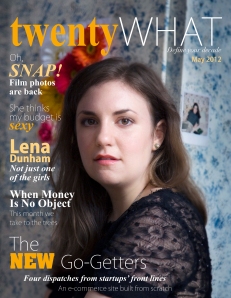Check out our May 2012 issue on issuu.com now!
twentywhatmag
Just another WordPress.com site
New in Town
Moving to a new city is both exciting and nerve-racking. Not only do you throw years of junk into boxes and lug them across the great American expanse, but you have to learn about your new digs. We know you’ve heard the typical new city advice — join a club, read a guidebook, study a map —so we want to give you some fresh ideas on how to get to know the neighborhood.
Blogs
Sites like nashvillest.com inform readers on local happenings, such as culture and arts, food and drink, music, and sports. Any questions you have or advice you may need can probably be found here. These sites can also be helpful for keeping up with the smaller, more unexpected bits of life. (Ever been to a Snuggie pub crawl?)
The Best ______
Begin a search for the city’s best (you fill in the blank). It could be anything from a bakery, food truck, or yoga spot. A personal quest will not only force you to find the unobvious charms of your new city, but it will provide you with an adventure and a goal to achieve. Just pretend you’re one of the Knights of the Round Table in search of the Holy Grail of burritos. You’ll have a blast (just leave the sword at home).
Bike
A unique alternative to public transit, biking allows you to navigate parts of the city that are otherwise hidden if you stick to the interstates and major streets. Wind through smaller streets to find the hole-in-the-wall places that help define the area (a neighborhood of quirky bungalows, an ethnic enclave, a park on the quiet side of town). Take in the sights and sounds you may not notice behind the wheel of a car. Best of all, you’ll get some exercise while doing it.
Become a Regular
Whether it’s a coffee house, diner, or bar, find a hangout and make it your own. Once the staff knows your name and can recite your usual order from memory, there’s a hefty chance the other regulars will get to know you, too. And there’s no better way to mingle and chitchat than over a house blend, bacon, or brew.
Take the Bus
Let someone else do the driving and take a bus route you’re not familiar with. Relax and stare out the window to observe the different places along this fresh route. And don’t hesitate to people-watch — you’ll find some of the city’s most original characters on the bus.
Depth of Field
There was a time when Parker Fitzgerald thought shooting with film was just about the dumbest thing in the world. Sure, it’s trendy, but no serious professional photographer would do that.
That was about two and half years ago. He started shooting with a Polaroid 100 camera and nowadays the 28-year-old Portland-based photographer fills his portfolio with film photos. The aesthetic of his work comes, in large part, from the look of film.
He goes for something beyond “a pretty girl and a pretty landscape.” In his work, he’s chasing a transcendent kind of beauty, a mood.
Often, the mood is that nostalgic feeling so absent from perfect digital photos. Fitzgerald’s work has a warm, rustic feel. The subjects of his photography, ranging from musical acts to fashion portraits, are mostly people,and they’re frequently outside in natural settings like wooded areas.
In the past few years, demand for the aesthetics of analog has stores like Urban Outfitters stocking cameras we thought time left behind—35mm, Holgas, Polaroids.
A recent report from the Photo Marketing Association shows that contrary to what you might expect, sales of digital cameras have gone down while sales of film cameras spiked 30-40 percent between 2009 and 2010. While digital cameras outsell film in terms of actual units sold, the film bump has been unexpected. Still,the digital camera slump may be due to the growing number of people content using their camera phones, as well as market saturation, but it might also be an indicator of something a bit loftier.
Fitzgerald thinks the appeal film photography holds for people his age has more to do with an appreciation for a process that’s slower, more purposeful, and linked to the past, than a drive to populate Tumblr and Facebook with artsy photos. “There’s a whole generation of kids who are now growing up and able to realize the fact that there’s something wonderful about the whole process of shooting on film,” he says. “You’re having to exercise a part of your brain that this culture in general tells you to ignore, which is your patience and discipline.”
There’s something of an entrance barrier getting into film. Many like Fitzgerald are self-taught, but Jim Dygert of MQ Camera Center in Syracuse, N.Y., says a lot of area high schools are still teaching film photography, and that drives younger folks into the store and into the habit of shooting with film. “They feel there’s more worth put into it,” Dygert says.
After all, between the roll of film and labor costs, every click costs anywhere from 15 cents to a quarter. The need to be deliberate and conscientious when shooting is part of the appeal for Fitzgerald. Instead of machine-gunning a quick hundred photos, photographers have to slow down and engage with the subject.
He says it adds value to every frame. “I think it’s healthy to pursue that quiet, nostalgic purposefulness in life, where you contemplate what your father and your father’s father did and why they did it that way,”Fitzgerald says, “and ask yourself: ‘Why are we doing it the way we’re doing it?’”
Check out exclusive photos of Parker in our May 2012 issue on pages 4 and 31!


